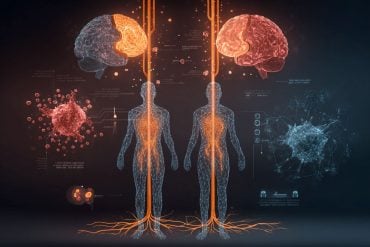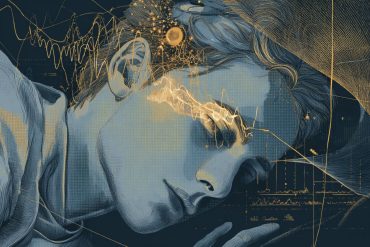Summary: Researchers find a region of the brain stem called the periaqueductal gray may mediate religiosity and spirituality in humans.
Source: Elsevier
Scientists have long suspected that religiosity and spirituality could be mapped to specific brain circuits, but the location of those circuits remains unknown. Now, a new study using novel technology and the human connectome, a map of neural connections, has identified a brain circuit that seems to mediate that aspect of our personality.
The work appears in Biological Psychiatry, published by Elsevier.
The study, led by Michael Ferguson, PhD, an investigator in the Center for Brain Circuit Therapeutics at Brigham and Women’s Hospital, Boston, MA, USA, shows that the brain circuitry of spirituality centers around a brainstem area called the periaqueductal gray (PAG).
“Patients routinely report that spiritual and religious experiences are among their most meaningful life events. Yet medical science historically has been shy about empirically studying the impacts of spirituality or its physiological mechanisms, Dr. Ferguson said.
“Now, we’re at a moment of sufficient cultural openness in science coupled with threshold technological proficiency in brain mapping that we don’t need to be so shy anymore about examining spirituality using our best scientific methods.”
Some people with neurological diseases such as schizophrenia experience hallucinations or ideations that are religious or spiritual in nature. And previous studies have shown that people with a certain type of epilepsy or with damage in specific brain areas could experience alterations in their spiritual identification.
Earlier research has also indicated that religious experiences are not the product of one particular brain region – that there is no so-called “god spot” – but that spirituality likely arises from dynamic activity across multiple brain regions.
In order to map the newly found brain circuit, Dr. Ferguson and colleagues examined previously collected data about self-reported spirituality from 88 patients before and after undergoing surgery for a brain tumor.
The researchers then used a technique called lesion network mapping to analyze how the site of each patient’s lesion, or tumor, interacts with the rest of the brain using a connectome dataset. That analysis revealed the PAG as a critical hub to changes in spiritual identification.
Dr. Ferguson and the team then confirmed the importance of the PAG by analyzing previously collected data from 105 veterans of the Vietnam War who experienced head trauma.
The PAG is an evolutionarily old brain structure known for its roles in fear response behaviors and autonomic functions such as regulating heart rate. The PAG is perhaps best known (and most studied) for its role in dampening pain by triggering the release of endogenous opioids, the brain’s own painkillers.
Dr. Ferguson and his colleagues were surprised to find the spirituality circuitry centered on the PAG, rather than “higher” brain regions such as the cortex, which is usually associated with cognitive function and abstract thoughts.

Dr. Ferguson added: “The fact that our results in this study point to such an evolutionarily ancient brainstem structure to define a circuit for spirituality is potentially significant for a litany of reasons. Among the more immediately material reasons is that the [PAG] is well-known to mediate pain inhibition. This leads to curiosity about ways that spirituality might be clinically relevant for helping manage physical and emotional pain.
“The fact that the [PAG] is also involved in attachment and bonding may also hint at mechanistic explanations for the emerging observation that spirituality can be effectively integrated into psychotherapy. These are of course early speculations about possible clinical relevance for the neuroscience of spirituality; the fact, though, that there is so much more work to do in this area is exhilarating and motivating!”
John Krystal, MD, Editor of Biological Psychiatry, said of the work: “It is important to understand that this study does not suggest that religion or spirituality in healthy people are in any way abnormal. Rather, this study identifies circuits in the brain that enable us to have religious or spiritual experiences.
“Researchers have long believed these circuits to exist, because some mental and neurologic illnesses can be associated with alterations in religious experiences, such as religious hallucinations or delusions. However, the study by Dr. Ferguson and colleagues now maps the brain circuits involved in religious experience and spirituality with new precision.”
About this neurotheology research news
Author: Rhiannon Bugno
Source: Elsevier
Contact: Rhiannon Bugno – Elsevier
Image: The image is in the public domain
Original Research: Closed access.
“A Neural Circuit for Spirituality and Religiosity Derived From Patients With Brain Lesions” by Michael Ferguson et al. Biological Psychiatry
Abstract
A Neural Circuit for Spirituality and Religiosity Derived From Patients With Brain Lesions
Background
Over 80% of the global population consider themselves religious, with even more identifying as spiritual, but the neural substrates of spirituality and religiosity remain unresolved.
Methods
In two independent brain lesion datasets (N1 = 88; N2 = 105), we applied lesion network mapping to test whether lesion locations associated with spiritual and religious belief map to a specific human brain circuit.
Results
We found that brain lesions associated with self-reported spirituality map to a brain circuit centered on the periaqueductal gray. Intersection of lesion locations with this same circuit aligned with self-reported religiosity in an independent dataset and previous reports of lesions associated with hyper-religiosity. Lesion locations causing delusions and alien limb syndrome also intersected this circuit.
Conclusions
These findings suggest that spirituality and religiosity map to a common brain circuit centered on the periaqueductal gray, a brainstem region previously implicated in fear conditioning, pain modulation, and altruistic behavior.






